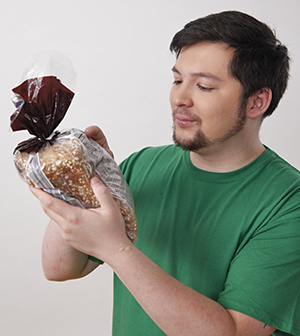Gluten-Free Diet for Celiac Disease
Celiac disease means that you are sensitive to a protein called gluten. Gluten is found in certain grains. When you eat gluten, your immune system causes harm to your small intestines. The treatment for celiac disease is to stay away from foods and products that contain gluten. You will need to do this for the rest of your life. Resist the temptation to “cheat.” Even a small amount of gluten can cause symptoms to return. And it can harm your body.
This sheet gives you the basics about a gluten-free diet. If you need help, a registered dietitian can teach you what foods and other products have gluten and how to keep away from them.
 |
| Reading food labels will help you stay away from foods with gluten. |
Always read labels!
Many foods may contain gluten, even if you think they don't. Get into the habit of reading ingredient labels before you eat.
Choosing foods
The most common source of gluten is wheat flour (this includes white flour). Wheat flour is used to make many baked goods, including breads, pastas, cereals, pastries, and pizza dough. Gluten is also found in many foods that you might not think would have it.
You will need to read food labels to look for gluten in everything you eat. But your diet does not need to be boring. Many foods are naturally gluten-free. And many foods commonly made with wheat flour now come in gluten-free forms.
|
Foods to stay away from
|
Foods you can eat
|
|
Bread, cereals, pasta, pastries, couscous, or pizza dough made with wheat flour (including white flour, farina, farro, emmer, durum, graham, and semolina)
|
Bread, cereals, pasta, pastries, or pizza dough made with rice flour, almond flour, beans, potatoes, and other gluten-free substitutes
|
|
Foods containing rye, barley (including malt), spelt, kamut, triticale, brewer's yeast, and bulgur
|
Foods containing corn, cassava, rice, amaranth, buckwheat, millet, quinoa, arrowroot, teff, soy, and tapioca
|
|
Processed meats
|
Fresh meats and seafood (beef, chicken, turkey, lamb, pork, fish, shellfish), beans, and tofu
|
|
Some dairy products with additives
|
Many plain dairy products
|
|
Many sauces, gravies, dressings, and condiments, including traditional soy sauce
|
Vinegar, oils, and gluten-free substitutes, tamari
|
|
Some granola bars and energy bars
|
Granola bars and energy bars labeled gluten-free
|
|
Some beers and spirits
|
Wine, and gluten-free beers and distilled spirits
|
|
Some soups
|
Gluten-free soups
|
|
Fruits and vegetables that are fried or breaded
|
Fresh fruits and vegetables
|
|
Many packaged foods
|
Packaged foods labeled gluten-free
|
|
Oats, especially if processed in a facility containing gluten products (check with your healthcare provider)
|
Gluten-free oats
|
|
Communion wafers
|
Gluten-free communion wafers
|
If you are exposed to gluten by accident
Staying gluten-free means always being aware. Even if you are very careful, mistakes can happen. The food you eat can't come into contact with gluten. This is called cross-contamination. Your meals must be made with utensils that have not touched foods that contain gluten. Shared knives, cutting boards, toasters, and storage containers are risks for gluten exposure. Shared condiments may have crumbs that contain gluten.
At restaurants, parties, and other places where you eat food prepared by others, ask how the food was made. Gluten can also be found in some nonfood items. Some medicines contain gluten. So do some vitamin supplements. Ask your pharmacist before taking a medicine or supplement.
Also, some shampoos, lotions, toothpastes, makeup, lipsticks as well as lip gloss and lip balm, glues, soaps, and other products contain gluten. It can be possible to ingest some gluten when using these projects. For example, this can happen if you use a lotion that has gluten and then touch food you eat. Children's clay and similar products have gluten. Any adult or child with celiac disease should wash their hands after handling these.
There is not much you can do if you have accidentally had gluten. Here are tips that might help you recover after being exposed to gluten:
-
Drink plenty of fluids
-
Eat small, frequent meals
-
Eat simple gluten-free soups or broths
-
Stay away from very spicy or fatty foods
-
Drink ginger or peppermint tea
-
Rest and relax
-
Get medical attention if you have severe symptoms such as vomiting or diarrhea
Coping with gluten-free living
Living gluten-free can be hard. But it can be done. Groceries have many gluten-free foods, but it's still a big change for many people. You may be upset that you can't eat your favorite foods, or eat freely at restaurants, parties, or over the holidays. Household members may also be upset by the strict controls over food.
If you face problems like these, think about joining a celiac disease support group. Support groups offer tips on how to make a gluten-free lifestyle easier on you and the people you live with. You can find ways to involve the people in your household. There are many ways to make gluten-free group meals. See the section on more resources below for help in finding a group.
Bring safe foods that you enjoy to parties and school or work events. This can help you not give in to the urge to grab something you shouldn’t eat.
Following up with your healthcare provider
You should see your healthcare provider at least once a year for a checkup. A simple blood test can show if your celiac disease is under control. If you are having symptoms, your healthcare provider can help you find sources of gluten you may have missed.
To learn more
To learn more about managing celiac disease, go to: